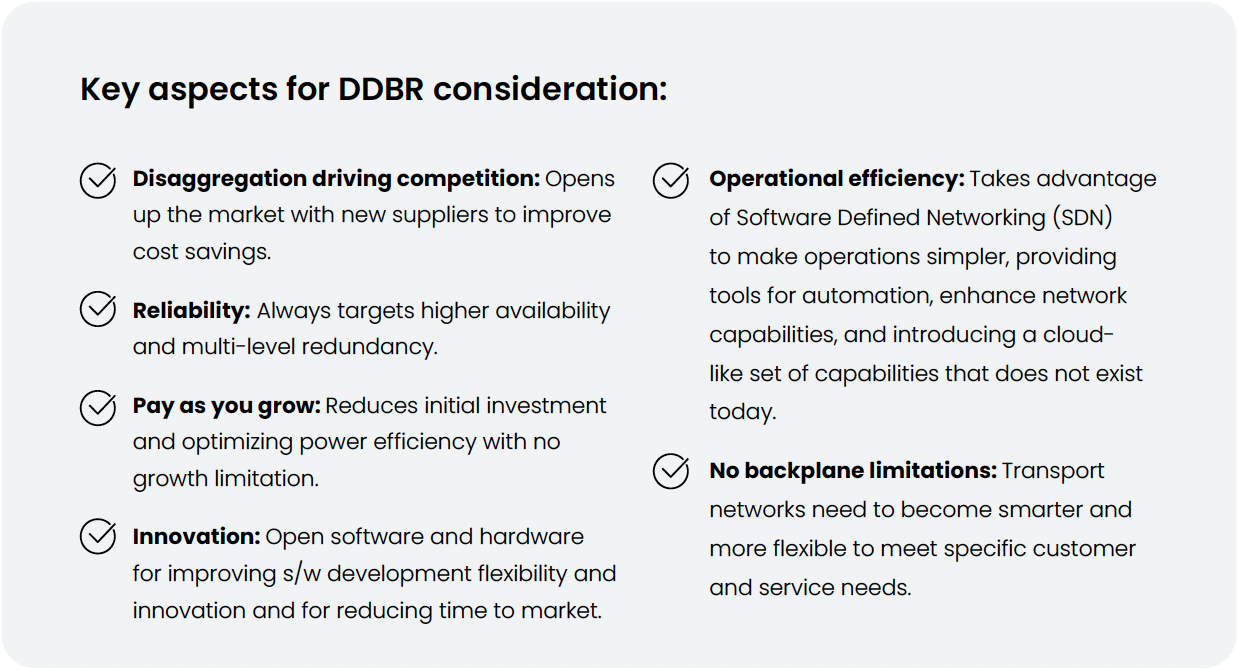Case Study: Network Scalability and Efficiency with DriveNets Solution


|
As part of the Telecom Infra Project (TIP), the Tier-1 operator, in collaboration with Vodafone, MTN and Telefónica, is driving open and disaggregated IP networking solutions. This has resulted in more operator flexibility and a wider range of technological choices for building and operating telecom networks. The group released in 2021 the Disaggregated Distributed Backbone Router (DDBR) Requirements Document outlining solution specifications. It includes a list of hardware and software requirements for building a high capacity, disaggregated, and open IP MPLS router that service providers can use to expand network capacity. The Tier-1 operator announced in June 2023 the successful deployment of TIP DDBR-compliant solution as its internet gateway peering router, which was delivered by DriveNets Network Cloud Distributed Disaggregated Chassis (DDC) approach. “DDBR dramatically increases network capacity, thanks to its capability to massively and simultaneously scale-out and scale-up for supporting ever-growing 5G traffic” says Kenji Kumaki, KDDI General Manager and Chief Architect, Technology Strategy & Planning. “Strategic deployment of this architecture coupled with flexible hardware and software will bring economic benefits.” |

THE CHALLENGE
The Tier-1 operator provides mobile, fixed-line, broadband and ICT services to millions of customers. As 5G services expand mobile communication use cases, the operator expects 5G traffic to increase rapidly due to the wide range and growing number of connected terminals. To sustain such growth, the operator needed to optimize its network infrastructure to support ever-growing 5G traffic and lower costs. As the operator started to plan its network evolution, they faced the challenge of deploying dedicated routers for each area of its carrier backbone network such as core, edge and internet gateway (GW). This increased the equipment capital cost and operational complexity.
Ultimately, the service provider wanted to increase its network capacity, agility and innovation by using open and disaggregated technologies that would enable it to choose the best combination of software, hardware and semiconductor chips for its use cases.
THE SOLUTION
The Tier-1 operator joined the TIP Open Optical & Packet Transport (OOPT) project group, which focuses on creating open and disaggregated solutions for optical and IP transport networks. The operator led the development of the DDBR solution which enables them to disaggregate/decouple hardware from software vendors and to share the same white box hardware infrastructure for multiple network domains such as core, aggregation, edge and internet GW.
The operator completed the DDBR technical requirements document in May 2021, and announced the first DDBR-compliant vendors in March 2022.
DriveNets was among the first vendors to be awarded a TIP Requirements Compliant Ribbon for the DDBR solution, which was the result of the initial phase of TIP’s test and validation process that evaluated industry readiness and solution availability for disaggregated core networking. The solution will be listed on the TIP Exchange.
After undergoing extensive commercial testing, the DriveNets-powered DDBR has demonstrated its capability to meet the requirements of software/hardware features, scalability, and multi-vendor interoperability in the operator production networks. The operator announced in June 2023 the selection of DriveNets DDBR, a use case of DriveNets Network Cloud DDC, as the software solution for its internet gateway peering routers.
The operator uses Delta Electronics white boxes that are powered by Broadcom’s merchant silicon (Jericho2) ASICs. The upgrade project enables the operator to scale its network and services quickly, while significantly reducing hardware requirements, lowering costs, and accelerating innovation.

THE RESULTS
By deploying DriveNets Network Cloud as part of TIP’s DDBR solution, the operator achieved several benefits:
- Scalability – Dramatically increased network capacity, enabling massive and simultaneous scale-out and scale-up to support future ever-growing 5G traffic.
- OpEx reduction – Reduced power consumption by about 46% and rack space by about 40% compared to the traditional routers in the operator production networks.
- CAPEX reduction – Utilization of the same white box hardware infrastructure for multiple areas such as core, aggregation, edge and internet GW. This enabled the operator to share spare hardware parts in its backbone networks, leading to a reduction in capital equipment costs.
- Accelerated innovation – Increased network agility and innovation by collaborating with different technology partners through TIP to enable customizable solutions while reducing costs.
The tier-1 operator was the first operator in their country to deploy a disaggregated IP infrastructure and one of the leading promoters of the development of open and disaggregated technologies for telecommunication systems through TIP. During the project, the operator emphasized two key elements: the freedom to create an optimal hardware configuration and the ability to share hardware resources across multiple network domains. These elements helped significantly reduce power consumption, equipment capital costs and rack space. The service provider plans to expand its use of DriveNets Network Cloud and deploy additional applications.
 |
SUMMARY
The telecommunications industry is witnessing a growing trend towards network disaggregation as service providers actively advocate its adoption. The operator joined the ranks of industry leaders such as AT&T, Turkcell, Telefonica, Vodafone and Orange in embracing open and disaggregated network solutions. AT&T, for instance, has already migrated over 52% of its production traffic to DDC design, while Turkcell has successfully deployed the DDBR Internet Gateway solution in its production network. These pioneers are reaping the benefits of disaggregation, including cost reductions, accelerated innovation, and enhanced scalability.
The tier-1 operator is a prime example of how operators can leverage TIP’s DDBR solution and DriveNets Network Cloud DDC to optimize their network infrastructure for massive capacity scale and lower cost. By using open and disaggregated technologies, the operator also increased its network agility and innovation while collaborating with its TIP technology partners. DriveNets is proud to be part of this journey, with the operator and TIP, and looks forward to supporting the operator’s network growth and further network transformation.





